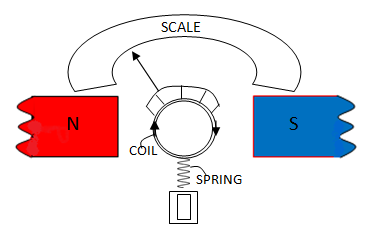
The relation between voltage sensitivity (${{\sigma }_{V}}$) and current sensitivity (${{\sigma }_{1}}$) of a moving coil galvanometer is (resistance of galvanometer if G)
$\begin{align}
& a)\dfrac{{{\sigma }_{1}}}{G}={{\sigma }_{V}} \\
& b)\dfrac{{{\sigma }_{V}}}{G}={{\sigma }_{1}} \\
& c)\dfrac{G}{{{\sigma }_{1}}}={{\sigma }_{V}} \\
& d)\dfrac{G}{{{\sigma }_{V}}}={{\sigma }_{1}} \\
\end{align}$
Answer
582k+ views
Hint: Current sensitivity is given as the deflection per unit current. Similarly voltage sensitivity is defined as deflection per unit volt. From the obtained equation current sensitivity and voltage sensitivity of a moving coil galvanometer, compare the equation and obtain a relation between the two quantities.
Complete solution:
First let us understand how a moving coil galvanometer works.

In the above diagram as shown a galvanometer consists of a coil placed in a radial magnetic field. When a current passes into the coil, it gets rotated due to the force by the magnetic field. Hence the coil experiences a torque equal to,
$\tau =NIAB\operatorname{Sin}\theta $ …… (1)
In the above equation N is the number of turns in the coil, A is the area of cross section I is the current through the galvanometer and $\theta $ is the angle between magnetic field and coil which is equal to 90 since the magnetic field is radial. Hence equation 1 can be written as $\tau =NIAB$
A scale is calibrated in such a manner that the rotation produces a deflection which shows the degree of current in the circuit.
A spring is attached to the coil which produces a restoring torque To bring the needle back to equilibrium. This restoring torque is given by,
${{\tau }_{S}}=k\phi $ …..(2), where k is the springs constant and $\phi $ is the angle of deflection.
At equilibrium,
$\tau ={{\tau }_{s}}$
Hence using equation 1 and two we get,
$k\phi =NIAB$
$\phi =\dfrac{NIAB}{k}$
As per the definition of current sensitivity and voltage sensitivity ,
Current sensitivity= ${{\sigma }_{1}}=\dfrac{\phi }{I}=\dfrac{NIAB}{kI}=\dfrac{NAB}{k}rad{{A}^{-1}}.........(3)$
Voltage sensitivity=${{\sigma }_{V}}=\dfrac{\phi }{V}=\dfrac{NIAB}{kIG}=\dfrac{NAB}{kG}rad{{V}^{-1}}..........(4)$ ,here G is the resistance of the galvanometer.
Using equation 3 and 4 let us compare ${{\sigma }_{V}}and{{\sigma }_{1}}$,
${{\sigma }_{1}}=\dfrac{NAB}{k}rad{{A}^{-1}}$ and ${{\sigma }_{V}}=\dfrac{NAB}{kG}rad{{V}^{-1}}$
If we observe the above equation the ${{\sigma }_{1}}$ can be substituted in equation of ${{\sigma }_{V}}$,
After substituting we get, $\dfrac{{{\sigma }_{1}}}{G}={{\sigma }_{V}}$
Hence, the correct answer is option A.
Note: Increasing current sensitivity does not necessarily mean voltage sensitivity also increases. Let us say we increase the current sensitivity by increasing the number of turns in the coil. But at the same time the voltage sensitivity gets decreased because the value of G increases as resistance is directly proportional to length.
Complete solution:
First let us understand how a moving coil galvanometer works.

In the above diagram as shown a galvanometer consists of a coil placed in a radial magnetic field. When a current passes into the coil, it gets rotated due to the force by the magnetic field. Hence the coil experiences a torque equal to,
$\tau =NIAB\operatorname{Sin}\theta $ …… (1)
In the above equation N is the number of turns in the coil, A is the area of cross section I is the current through the galvanometer and $\theta $ is the angle between magnetic field and coil which is equal to 90 since the magnetic field is radial. Hence equation 1 can be written as $\tau =NIAB$
A scale is calibrated in such a manner that the rotation produces a deflection which shows the degree of current in the circuit.
A spring is attached to the coil which produces a restoring torque To bring the needle back to equilibrium. This restoring torque is given by,
${{\tau }_{S}}=k\phi $ …..(2), where k is the springs constant and $\phi $ is the angle of deflection.
At equilibrium,
$\tau ={{\tau }_{s}}$
Hence using equation 1 and two we get,
$k\phi =NIAB$
$\phi =\dfrac{NIAB}{k}$
As per the definition of current sensitivity and voltage sensitivity ,
Current sensitivity= ${{\sigma }_{1}}=\dfrac{\phi }{I}=\dfrac{NIAB}{kI}=\dfrac{NAB}{k}rad{{A}^{-1}}.........(3)$
Voltage sensitivity=${{\sigma }_{V}}=\dfrac{\phi }{V}=\dfrac{NIAB}{kIG}=\dfrac{NAB}{kG}rad{{V}^{-1}}..........(4)$ ,here G is the resistance of the galvanometer.
Using equation 3 and 4 let us compare ${{\sigma }_{V}}and{{\sigma }_{1}}$,
${{\sigma }_{1}}=\dfrac{NAB}{k}rad{{A}^{-1}}$ and ${{\sigma }_{V}}=\dfrac{NAB}{kG}rad{{V}^{-1}}$
If we observe the above equation the ${{\sigma }_{1}}$ can be substituted in equation of ${{\sigma }_{V}}$,
After substituting we get, $\dfrac{{{\sigma }_{1}}}{G}={{\sigma }_{V}}$
Hence, the correct answer is option A.
Note: Increasing current sensitivity does not necessarily mean voltage sensitivity also increases. Let us say we increase the current sensitivity by increasing the number of turns in the coil. But at the same time the voltage sensitivity gets decreased because the value of G increases as resistance is directly proportional to length.
Recently Updated Pages
A man running at a speed 5 ms is viewed in the side class 12 physics CBSE

The number of solutions in x in 02pi for which sqrt class 12 maths CBSE

State and explain Hardy Weinbergs Principle class 12 biology CBSE

Write any two methods of preparation of phenol Give class 12 chemistry CBSE

Which of the following statements is wrong a Amnion class 12 biology CBSE

Differentiate between action potential and resting class 12 biology CBSE

Trending doubts
What are the major means of transport Explain each class 12 social science CBSE

Which are the Top 10 Largest Countries of the World?

Draw a labelled sketch of the human eye class 12 physics CBSE

Explain sex determination in humans with line diag class 12 biology CBSE

Explain sex determination in humans with the help of class 12 biology CBSE

Differentiate between homogeneous and heterogeneous class 12 chemistry CBSE




